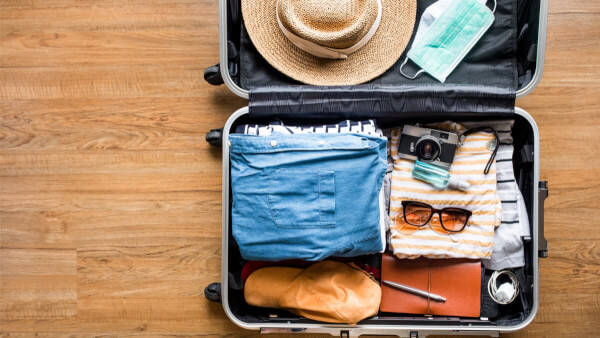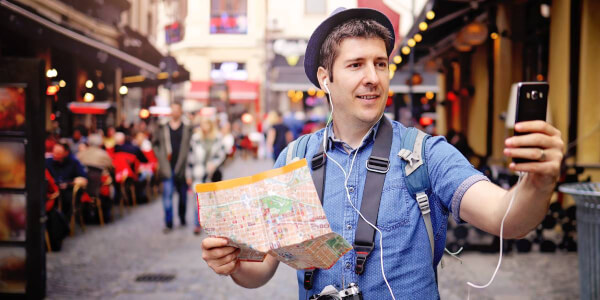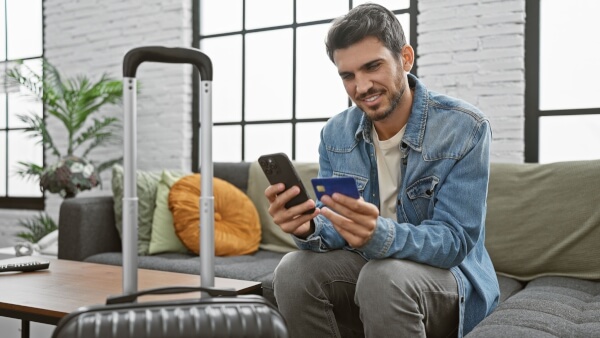UBank vs Wise card - Which is the better travel card to use overseas in Australia?
Looking for a travel card to use overseas? We compared the fees, features, and benefits of two top travel cards: Ubank vs Wise, for Australian travellers.

NAB travel card: Foreign currency rates and fees explained
How do you pay for stuff when you go abroad? It’s a simple question, with - traditionally - an irritatingly complex answer. Thanks to the bad exchange rates and a plethora of extra fees that banks have charged, it’s often been quite expensive to get hold of foreign cash or use your Australian credit or debit card abroad.
But times are changing. Thanks to new technology, the number of ways you can spend money internationally has never been greater. Travel money cards are a key example of this: with a travel money card, you can hold money in multiple international currencies and use it abroad to withdraw cash or make payments.
Before you get started, a word.
Banks often charge hefty fees for foreign and multi-currency accounts. And if you’ve already tried managing multiple accounts in multiple countries, you know it’s rarely simple.
Wise could help. With Wise, it’s free to open a borderless multi-currency account with no monthly fees. There, you can manage and send dozens of different currencies all from the same account. All around the world. (Likely, for a lot cheaper than your bank.)
Give it a try. Check out Wise today.
Now, back to what you came here to read.
The NAB Traveller Card is the National Bank of Australia’s offering. It lets you put money on it in up to 10 currencies, and it’s a Prepaid Mastercard, which means it can be used very widely around the world.
This article will take a closer look at the NAB Traveller Card and explain what it gives you. It contains information on:
First of all, let’s get back to basics. Why is it so tricky to get a good deal when you spend money abroad?...
The answer’s simple: exchange rates.
First of all, as you likely know, foreign exchange rates change all the time, as international markets go up and down. But what makes matters worse is that currency exchangers, whether they’re banks or specialists, set their own exchange rates. They base them on the mid-market rate, which is an average of all the buy and sell rates at that point in time… but they usually mark that rate up, so you get less foreign currency in exchange for your Australian dollars.
So the exchange rate changes not just depending on when you make the transfer, but also where.
Is it ever possible to get money converted at the mid-market rate? It is: Wise offers this rate to all its customers. But if you use a bank, it’s pretty unlikely you’ll get that.
If you have a card with foreign currency on it, you know exactly how much you have in that currency - and the amount stays the same whatever the exchange rate does. That’s what you get with a travel money card.
With an Australian debit or credit card, on the other hand, you’re holding the money in Australian dollars, so every time you use that card to pay in a foreign currency, the money has to be converted. What that’ll cost you depends on exactly what the exchange rate is at the time - plus it might cost you additional fees, depending on your card. That’s a lot of uncertainty, and potential extra costs, which is why the specialist travel money card is so handy.
With a travel money card, the other bonus is of course that you don’t have to carry a wad of cash around.
Back to the NAB Traveller Card itself. Unsurprisingly, when you put money on this card, it’ll be converted at NAB’s own foreign exchange rate which is very likely some percentage off the true mid-market rate¹.
How does that rate compare to the mid-market rate? Check for yourself by consulting our online currency converter that works like Google or XE.
Aside from the marked-up exchange rate, what will you have to pay for the NAB Traveller Card? Here’s an overview. It’s not 100% definitive: you should check directly with NAB for a full list².
| NAB Traveller Card fee | Description and amount |
|---|---|
| Initial fee | None |
| Top-up/reload fee | None |
| Foreign ATM withdrawal fee | No fee from NAB, although the ATM operator might charge one |
| Australian ATM withdrawal fee | AUD 3.75, and again a possible fee from the ATM operator |
| Fees for foreign currency conversion | If you make a transaction in a currency in which you don’t hold money on the card:
|
| “Currency to Currency” exchange rate | You get this exchange rate when you:
|
That’s a relatively short list of fees - which is great news. Do watch out for the exchange rate, though.
NAB offers 10 currencies on its travel card¹:
How much - and how little - can you put on the card? Take a look²:
| Limit | Amount |
|---|---|
| Minimum load amount | AUD 50 (or foreign equivalent) |
| Maximum load amount in a branch | AUD 45,000 (or foreign equivalent) |
| Maximum load amount via BPAY | AUD 25,000 (or foreign equivalent) |
| Maximum total on card (across all currencies) per year | AUD 45,000 (or foreign equivalent) |
| Daily ATM withdrawal limit | AUD 3,000 (or foreign equivalent) |
| Daily transaction limit | AUD 7,000 (or foreign equivalent) |
The NAB app is available from both Google Play and the App Store, so you’re sorted whether you use Android or Apple. It’s not specifically designed for the Traveller Card, but via the app you can still manage your account - including topping up with more credit¹.
There’s a lot to commend the NAB Traveller Card. Compared to many competitors, the minimum load fee of AUD 50 is conveniently low, and via internet banking, reloads are instantaneous. The lack of ATM fees is also an attractive feature, and so is the lack of an “inactivity fee” - some travel card providers charge you a monthly fee if you don’t use your card for a year or so. It’s very useful that the NAB card automatically comes with a backup card, too: if you do lose it, you’ll have a spare to fall back on.
All that said, it’s the exchange rate you’ll have to watch out for. Just because you’re not being charged a “fee” doesn’t mean you get something for nothing. Every time you convert money, there will be a little cut of that going to NAB. So make sure you’re happy with that deal.
You can also get the Wise travel money card on which you can convert funds at the real mid-market rate. The debit cards work alongside a Wise borderless account, which is a convenient way to store money in 40+ international currencies. So if that’s a feature that interests you - or you just want to be sure to get the best deal on the exchange rate - then Wise could be worth checking out.
Ready to take this further? Here’s how.
You’ll need to go to a NAB branch to get hold of one. There’s no need to order in advance - just turn up and they’ll sort you out¹.
There are no additional steps needed to activate it - it should be working as soon as there’s credit on it¹.
The NAB Traveller Card is a Prepaid Mastercard, so you can use it more or less like any other Mastercard. It’ll be fine for ATM withdrawals, purchases, online shopping and so on, so long as Mastercard is accepted there.
You can top up or reload your balance in several ways:
With NAB internet banking, your topped up funds will appear in your account straight away. With other methods, there might be a wait¹.
If you used to get foreign cash before a trip, you might remember the “buy back” service, where your currency exchanger would buy any leftover currency back from you when you got home. With a card, it doesn’t quite work like that, but it’s still easy enough to free your money up after the trip.
If you bank with NAB, it’s especially easy - just use internet banking to move your money to another account. If you don’t, you’ll need to complete a form, and then your funds can transfer to another Australian account¹.
If you want to get in touch with NAB directly about the card, head over to their website or give them a call on the number on their homepage¹.
In case of emergency, here’s a little advice.
Get in touch with NAB as soon as you can, if your card is lost or stolen, and if it’s so damaged that it doesn’t work, you should probably do the same.
Don’t forget that you’ll have been issued a backup card - so you should be able to keep going, so long as you’ve stored the backup card in a separate place¹.
There are always a few reasons why a card might be declined. Here are some questions to ask yourself:
If you’re still stumped, you might have to get in touch with NAB.
It happens to the best of us… if you forget your PIN, you’ll have to give NAB a call. If you can prove you’re you, you’ll get a reminder².
Has your card been blocked? Check through the “Declined” list above, and if you’re still not sure what’s going on, the best advice is to call NAB.
Everything expires - even NAB Traveller Cards. After its expiry date, you won’t be able to use it, so make sure it’s got enough time left to see you through your trip.
When the card’s about to expire, make sure it’s set up to put your money back into another account of yours².
Every traveller should bear the following points in mind when it comes to money abroad.
Perhaps the NAB Traveller Card is right for you, perhaps not. But either way, make sure you get a good deal when you spend money abroad, so you can concentrate on the most important thing of all: enjoying yourself.
https://www.nab.com.au/personal/international/nab-traveller-card 20 January 2019
https://www.nab.com.au/content/dam/nabrwd/documents/pds/travel/nab-traveller-card-pds.pdf 20 January 2019
This publication is provided for general information purposes only and is not intended to cover every aspect of the topics with which it deals. It is not intended to amount to advice on which you should rely. You must obtain professional or specialist advice before taking, or refraining from, any action on the basis of the content in this publication. The information in this publication does not constitute legal, tax or other professional advice from TransferWise Limited or its affiliates. Prior results do not guarantee a similar outcome. We make no representations, warranties or guarantees, whether express or implied, that the content in the publication is accurate, complete or up to date.
*Please see terms of use and product availability for your region or visit Wise fees and pricing for the most up to date pricing and fee information.
This publication is provided for general information purposes and does not constitute legal, tax or other professional advice from Wise Payments Limited or its subsidiaries and its affiliates, and it is not intended as a substitute for obtaining advice from a financial advisor or any other professional.
We make no representations, warranties or guarantees, whether expressed or implied, that the content in the publication is accurate, complete or up to date.

Looking for a travel card to use overseas? We compared the fees, features, and benefits of two top travel cards: Ubank vs Wise, for Australian travellers.

Planning to use your UBank card to make ATM withdrawals internationally? Read on to understand the true cost of overseas transactions with UBank.

Wondering if Travel Money Oz is the right solution for you? Our guide outlines everything you need to know about their currency exchange and travel money cards.

If you're trying to decide between Travelex and Travel Money Oz for your international money needs, read on for our side-by-side comparison of the features.

Side-by-side Comparison of Westpac Travel Card vs Wise Travel to help Australian users decided which is a better travel card for spending abroad.

Looking for a card for international transactions while traveling overseas? Read on for our guide to the options available with Macquarie Bank.